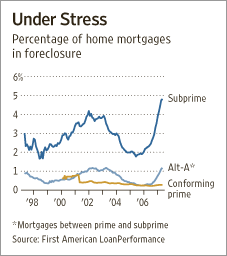From Inman News:
The housing market: How bad will it get?
Speculation, rampant building, risky loans, overborrowing and escalating prices propelled the housing market to an unprecedented peak — and are now counted among its greatest failings.
The “soft landing” that so many analysts and economists had predicted has given way to a record number of foreclosures, an implosion in the subprime lending market, an oversupply of housing, and home-price declines in many market areas. The dreamy days of the housing boom have received a cold slap of reality.
Real estate markets are historically cyclical — that’s nothing new. But in this case, the nation is in the midst of a downturn following a long-lasting and massive real estate run-up, and it remains to be seen whether this period will become known as one of the greatest real estate slumps in history.
How bad will the real estate market get before it gets better? Many experts have said they don’t expect a quick return from these doldrums, and this outlook could turn dire if the overall U.S. economy hits a snag. While there is not a nationwide epidemic of job loss, there are worries about rising inflation and energy prices, and declining consumer spending.
David Shulman, of the Anderson Forecast at the University of California, Los Angeles, said in his latest report that he expects a 10 percent peak-to-trough home-price decline that could extend into 2009, with the swell of foreclosures growing “well into 2008.” His forecast report bears a one-word title: “Turbulence.”
Real estate industry consultant John Burns said during a housing conference in May that the buyer’s market will continue for at least two more years, and “we’re heading into a year with more price declines,” with builders dropping prices by about 20 percent in some markets.
The National Association of Home Builders expects a 21 percent drop in total housing starts and an 18 percent drop in new-home sales this year compared to last year, and the National Association of Realtors expects a 4.6 percent drop in existing-home sales, a 1.3 percent drop in median existing-home prices and a 2.3 percent drop in new-home prices this year compared to 2006.
…
The sensational rise of the housing boom may be a key factor in its demise.“This was sort of a market-fed downturn,” said Jay Q. Butler, director of Realty Studies at Arizona State University’s Morrison School of Management and Agribusiness. The rapid upswing in home sales and pricing was not sustainable, he said.
“A lot of the system was being stretched, both legally and illegally to some degree, with the idea that this was going to continue. So people got in over their heads. It really sort of turned in on itself. You usually find a (real estate) downturn associated with a downturn in the economy — we really haven’t seen the downturn in the economy.”
Likewise, the latest annual housing market report by Harvard University’s Joint Center for Housing Studies stated that the housing downturn “has been driven largely by the market’s own excesses,” including an oversupply of new homes that was artificially inflated by activity among investors and speculators.
Some familiarities exist now from past cycles, Butler said. For example, in a real estate boom there are always people who overextend themselves financially to purchase homes during a real estate boom, perhaps thinking that they will be able to sell the home for a profit based on the appreciation trends.
“I don’t think we really ever learn. The lenders and real estate agents and everybody else is more than willing to help people achieve this goal (of home ownership) because they make a commission for you to achieve this goal,” Butler said.
…
The lesson to be learned from this market cycle is that there was “way too much flexibility” in the loan products offered to consumers, which ultimately led some consumers to buy homes that they couldn’t afford, Jacobson said. “Sometimes that’s not the right house … they may not like what they hear but that’s the right answer.”
…
He said he would support a giant banner with a statement to consumers: “Stop going out and shopping like it’s a bottle of catsup.” He added, “There are a lot of people who are encouraging people not to do the right thing. During those boom years there were a lot of people getting into programs that were risky for them as well as the lender (and) were putting people really on the margin,” he said.

